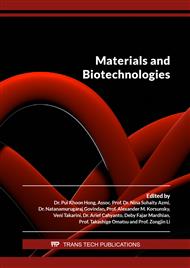p.129
p.135
p.145
p.153
p.161
p.167
p.177
p.183
p.193
The Effect of Horn Beetle Nano Chitosan (Xylotrupes gideon) on the Surface Roughness of Glass-Ionomer Cement
Abstract:
The purpose of this study was to evaluate the effect of adding horn beetle nano chitosan (NCH) to Glass Ionomer Cement (GIC) liquid on surface roughness. The evaluation was done before and after the addition of NCH and from the length of time soaking in artificial saliva. The disc sample with a diameter of 6 mm and a height of 3 mm of total 40 samples were divided into four groups: the GIC control group, GIC modified NCH 0.5%, 1%, and 2%. Each sample was immersed for 24 hours and seven days in artificial saliva. Surface roughness before and after immersion was measured using the Surtronic S-100 Series Surface Roughness Tester. Data analysis was performed using a one-way ANOVA test to determine the effect of adding horn beetle NCH and paired t-test to determine the effect of immersion time on the surface roughness of GIC. Although the highest surface roughness values were found in sample GIC modified NCH 1% (2.51±0.86 for 24 hours) and in sample GIC modified NCH 2% (2.64±0.84 for 7 days), there was no significant differences for both the surface roughness with the addition of NCH (p > 0.05) and the length of immersed time (p > 0.05). As the conclusion, there is no effect of horn beetle nano chitosan to GIC surface roughness. However, the addition of horn beetle NCH presented rougher surfaces after immersion. These experiments can help predict the performance of these materials under clinical conditions.
Info:
Periodical:
Pages:
161-166
Citation:
Online since:
August 2022
Price:
Сopyright:
© 2022 Trans Tech Publications Ltd. All Rights Reserved
Share:
Citation:



